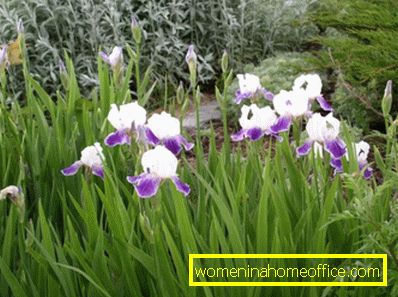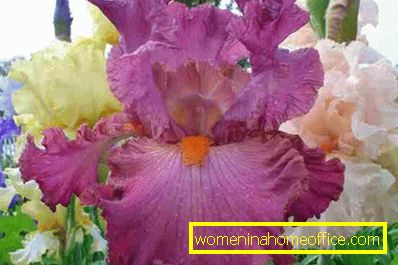Varieties of bearded irises
For a half century of cultivation of irises, many of their varieties were bred, one of which is bearded iris. They got their name from the so-called beard, located on the outer parts of the perianth.
On the basis of plants belonging to this species, many hybrids have been developed and they are used for decorative purposes. This variety includes a lot of large-flowered irises. Depending on the height of the peduncle itself, these plants are divided into several subgroups: undersized, reaching a height of 25 to 37 cm; sredneroslye - from 37 to 70 cm and tall - from 70 cm and above.
Bearded Iris: Varieties and Varieties
Flower growers usually grow such varieties of bearded irises as:

- Iris Alberta. In this variety, the peduncle is branched, it reaches a height of 60 cm. A plant can bloom 3-5 or less likely 7 flowers that have a purple color and are odorless. Less often white flowers. The leaves are wide and have a purple-purple shade at the base. This variety of plant begins to bloom in late May - early June. This iris tolerates winter well and is resistant to bacteriosis. True, it is also not without flaws - the ends of its leaves often shrink and their wrapping swells up. This flower looks great in front gardens or on rocky hills.
- Leafless Iris It reaches a height of 50 cm, 3-5 flowers bloom on it in a bright purple color, with a faint odor. The leaves have the shape of a sickle, which die off with the approach of winter and re-grow in the spring, after the peduncles, which is why this type of plant got its name. Often used for breeding sredneroslyh varieties. Flowering begins in mid-May, not afraid of winter. In many regions in nature nowadays begins to disappear.


- Iris is pale. This species belongs to tall and reaches a length of up to 80 cm. The flowers have a pale blue color, with a pleasant strong aroma, on very short pedicels. The leaves are thin, dry and rustling, have a gray color with a waxy coating. This variety blooms in early June, is often used to produce iron, that is, flower oil. This sort of overmoistening is afraid, it is necessary to observe a measure at watering.
- Iris dwarf. Most often found in southern Ukraine and in the North Caucasus. Peduncle with a height of only 3 to 5 cm. The flowers are light yellow, blue-violet or very rarely - white, they have no aroma. The leaves reach a length of 10 cm. This type of plant blooms in early May and is the ancestor of dwarf irises.

- Iris motley It reaches a height of 45 to 55 cm. It blooms from 3 to 6 two-colored red-brown closer to the edge and yellowish inside the flowers. The leaves are wide, sometimes curved in the shape of a sickle. It starts blooming at the end of May-beginning of June. Perfectly conveys its species characteristics to posterity.
- Iris horned. It is similar to leafless iris, it has a thin branched peduncle, on which small dark purple flowers are formed. The leaves are straight and narrow, blooms in late May - early June.
- Florentine iris. It has a high branched peduncle, it reaches a length of 70 cm, on which 5 to 8 flowers are formed, of soft blue color, having a pleasant aroma. Leaves gray and large. It blooms in late May, breeds only vegetatively. For the winter it is necessary to shelter.
Bearded irises: photo




Read also:
- Flower bed continuous flowering
- Unpretentious flowers to give
- Why do not bloom irises?
Bearded Irises: landing and care
Plant this variety of irises in a sunny place that is protected from the wind. The soil they like is heavy, sour and damp, the best option is alkaline or slightly acidic earth. If the ground is heavily overmoistened, then drainage is necessary. Still, these plant varieties grow well on stony soils and high beds.
It is impossible to fertilize the soil with organic fertilizer, it can cause various diseases. In the process of planting can not deeply dig the roots in the ground, otherwise the iris will not bloom, because it will need a lot of force to push its rhizomes to the surface, and in the worst case, it will rot and die. Before planting, you need to dig a small hole, and in the center pour a small mound on which the roots will be located. After the rhizome, sprinkle with 1-2 cm of sand, and the hole itself - with soil and slightly compacted. The best orientation of the rhizomes during planting is south, so the roots warm up better, which is the prevention of various diseases.

If the garden area is small, then you do not need to plant the plants too closely. Overcrowding will weaken the plants, lead to the development of diseases and the quick closing of the leaves.
High varieties of bearded irises should be planted at a distance of 50 cm from each other, and dwarf ones - 30 cm. If the irises grow in one place for a long time, then regular fertilizing with fertilizers should be carried out. In early spring, you can apply nitroammofosku, and then - only phosphate - potash fertilizers (2 dressing should be carried out before the appearance of buds, and 3 - at the end of flowering). A surplus of nitrogen activates the growth of roots, which makes them vulnerable to winter and strong frosts.
Bearded irises should be weeded regularly, but not deeply, since their roots are located practically on the surface. From the second half of August, weed these flowers better with our hands. Abundant watering irises are not needed, it is better to water them altogether only as the soil dries. Mandatory watering during transplanting or in a too dry period.
One of the important points in the cultivation of bearded irises is their rejuvenation, namely, transplanting and thinning the roots. So will gain additional resistance to disease.
Diseases of bearded irises and their treatment
The most dangerous disease for plants is bacteriosis or soft rot of roots. First of all, the leaves change their color, then their ends dry and turn brown. In the part of the stem from which they grow, rot forms, which subsequently passes to the rhizomes. The leaf fan rots and falls off, an unpleasant smell emanates from the roots and they turn into a mushy mass.

In order to avoid the appearance of this disease, during transplantation, it is necessary to inspect all the material, and to process the plant sections with a strong solution of potassium permanganate. It is better to dry the roots of transplanted plants in the sun during the day, because this bacterium is afraid of sunlight.
If the disease is found in a growing iris, then with a clean, sharp knife, cut off the affected area, moisten the cut itself and sprinkle it with “Komet” powder, which is used for commercial purposes. Shallow burying of roots during planting and application of potash and phosphate fertilizers to the soil with trace elements will increase the resistance of these plants to diseases.
Another disease of bearded irises is leaf spotting. It can be formed due to excessively wet soil. First, the outer leaves are affected. They form spots that gradually fill the entire surface. Such leaves should be removed immediately, but only in the case when they are easily separated from the roots. Strong leaves should not be touched, in order to avoid the appearance of wounds through which the pathogens of bacteriosis penetrate.
A good protection against this disease is spraying irises with a solution of Arcerid or Polyhome 2-3 times before the development of the disease.
A relatively rare and relatively new disease of bearded irises is scorch. In the middle of the growing season, the leaves turn brown, dry and bend, and the roots become hard and dry. The cause of this disease has not yet been identified, as well as measures to combat it. Sick plants must be dug together with a clod of earth and burned, and the growth site must be treated with formalin or lime.

Preparing bearded irises for winter
Bearded irises tolerate strong frosts with a steady snow cover. But sudden changes in temperature, both in winter and in autumn and winter, adversely affect the plants. Especially dangerous are the spring frosts after warm days, at the moment when the flowers have already departed from hibernation. Protracted autumn rains also have a negative effect on the irises, because they have to go into wintering dry.
If the plants are provided with proper care, they will develop well and grow. At this time, free space in the flower bed can be planted with small-bulbous summer plants that do not give self-seeding. This will be an excellent addition to the flowers, but even without this blooming irises http://womeninahomeoffice.com.ru/dom-i-xobbi/czvetovodstvo/sadovye-tsvety/pochemu-ne-tsvetut-irisy is a fantastic spectacle. The main plus is that they do not need to be planted every year, you can just cover them well for the winter.